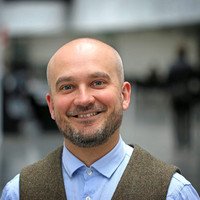Workshops, networking and hackathons build community and knowledge on X-ray tomography and food science
Participants at the hackathon and the introductory workshop on tomography, pictured at LINXS, in October.
During autumn, the Northern Lights on Food theme has organised many activities with the aim to bring communities of food researchers together in different parts of Sweden and to increase knowledge of existing and new infrastructures and techniques. The ambition is to advance food science, support the use of X-rays and neutrons, and build networks.
Francisco Vilaplana is professor and head of the Department of Glycoscience at KTH.
In this article, some of the researchers involved in the theme reflect on the outcome of these events, and highlight the value of LINXS.
Francisco Vilaplana, professor and head of the Department of Glycoscience at KTH, was part of organising a workshop aimed at presenting existing and new infrastructure available at KTH and SLU for the understanding of food complex materials in September in Stockholm. He is very happy with the outcome, not least that the event included a visit to the Laboratory of Foodomics at KTH FOOD, the National Infrastructure for Nuclear Magnetic Resonance and the Molecules and Materials at Interfaces” laboratory – 2MILab at KTH.
– The more we know about what is going on at different places in terms of infrastructures, and the more we learn about possibilities, the better we can connect with each other and find new avenues to explore in our work, says Francisco Vilaplana.
He continues: – At some point, we as researchers have to stop looking inwards, and start widening our networks to create new collaborations. This event was a very good start!
Workshop on tomography imaging highlighted key basics
Marjorie Ladd Parada, postdoctoral researcher at the Department of Glycoscience at KTH, and member of Francisco’s research group was part of a team which organised two events connected to food structure and tomography imaging, which took place in October: an introductory workshop and a hackathon. They were scheduled back-to-back to allow researchers to first learn the basics, and then try some hands-on imaging experiments and data analysis exercises.
Marjorie Ladd Parada is postdoctoral researcher at the Department of Glycoscience at KTH.
She explains that it was important to provide a good overview of tomography at the first workshop so that people who had never tried it before could understand how it works and how it can add value to their research. It also included presentations of more specialised techniques, such as tensor tomography and SWAXS mapping, and an introduction to the ForMAX and SoftiMAX beamlines at MAX IV.
– So many people want to get started but don’t necessarily know how, or don’t know the right people, or what techniques to use. This event was for them: to simply show what can be done by using tomography, says Marjorie Ladd Parada.
During the day, several examples of how to image peas, oats, and bread were highlighted to spark interest and inspire the participants, who numbered to about 20 people altogether, and included industry representatives.
– The idea was to show how you can use tomography or other imaging techniques for different purposes: all the way from imaging a single object to capturing in-situ processes, says Marjorie Ladd Parada.
The different presentations generated lots of questions. Of particular interest was information related to samples, sample environments and the beamline proposal process, notes Marjorie Ladd Parada.
– Since many people were new to the technique, and to X-ray experiments per se, it was nice to be able to give input and to really discuss what aspects should be included in a proposal, and key things to know about samples.
Hackathon inspired participants to get started with image analysis
The hackathon followed right after the workshop. The hackathons have been organised yearly at LINXS by Stephen Hall, senior lecturer at Solid Mechanics at Lund University, previous LINXS director, and theme leader for the Imaging theme which concluded in 2020. This year, one of the aims was to attract beginners, to help them get started with their first imaging experiments. To facilitate participants who had no previous experiences, they first visited the 4D Imaging Lab at Lund University to measure a Lego man and a dry pea, to provide everyone with some data to use.
– The message that we wanted to send is that there are many ways to get started. That is also why we included presentations on different software you can use to analyse data, such as Dragonfly and Python, and how you can start to write your own code, says Marjorie Ladd Parada.
– Image analysis is becoming more and more of a bottleneck for researchers who want to make the most use of their results. Put simply, we need to help people to understand what to do with their data once they acquire it.
Events helped bring people together
Francisco Vilaplana and Marjorie Ladd Parada’s own research interest covers wheat bran, and how different extraction methods can affect its hierarchical structure from the nanoscale to the microscale. This research has been ongoing for over eight years in Francisco’s research group, and along with colleagues at KTH, they are trying to valorise different types of side streams from agricultural production to see how they can be used for functional materials and healthy food ingredients.
Marjorie reflects – I am very happy with how the two events turned out! It was great to see people connecting, to have industry in attendance, and to make new contacts. Too often one is unaware of what is going on, even in close by universities such as Stockholm University and SLU, but now we have overcome some of those barriers.
Read more about the Northern Lights on Food theme



